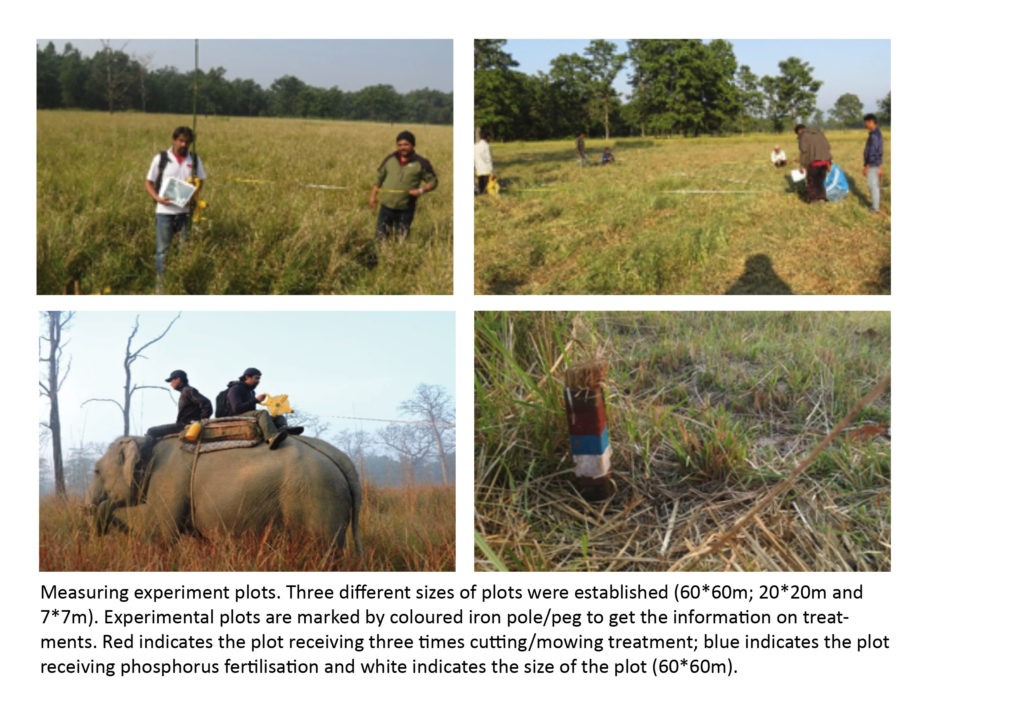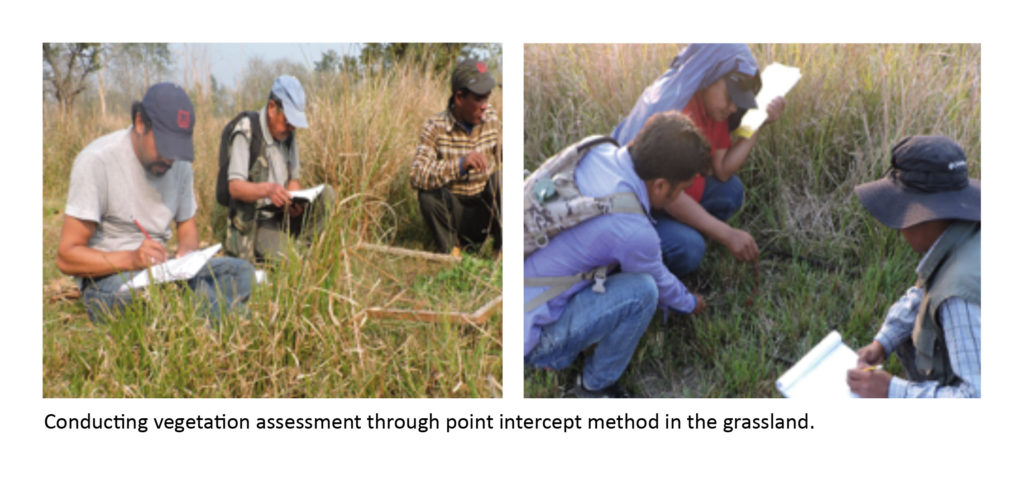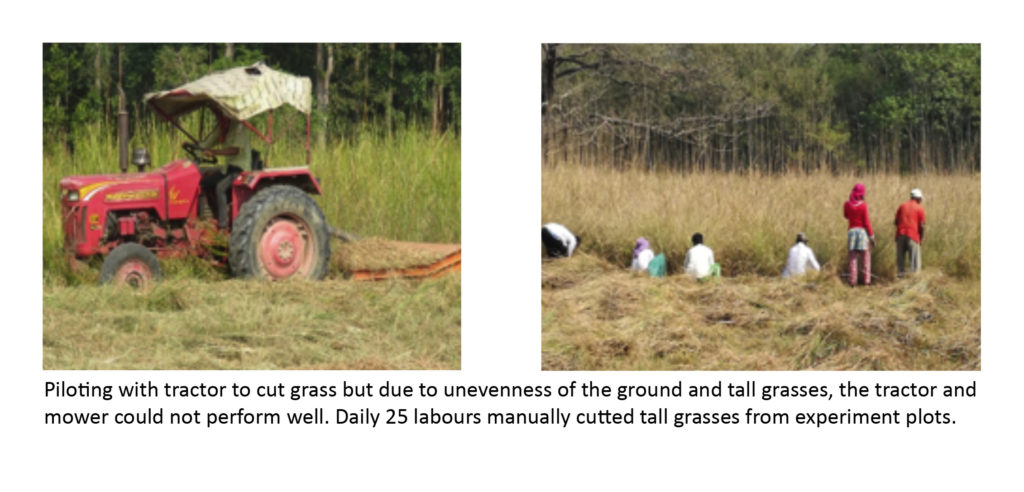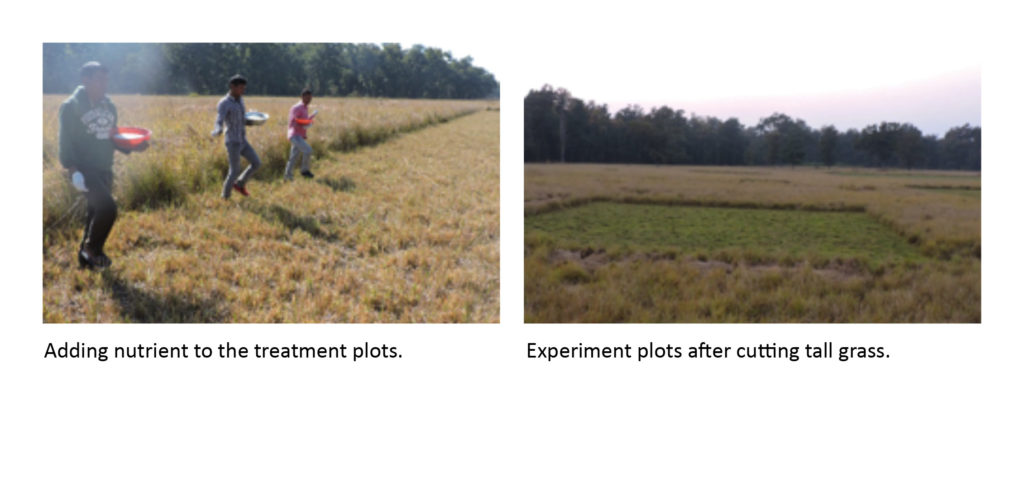Shyam Thapa is head of the National Trust for Wildlife Conservation in Bardiya but also PhD-student at Wageningen University under supervision of Prof. Dr. Herbert Prins. He is addressing an exiting research issue: how can the quality of grasses in the sub-tropical grasslands of Nepal be improved? We asked him to write this newsletter about his field experiments now being carried out.
Habitat quality
As the other tiger range countries, Nepal is striving towards doubling the number of tigers by the year 2022. The key question is how this can be best achieved.
Habitat quality and prey-base density can influence the long-term survival of the tiger population. The sub-tropical region of Nepal was once a continuous forest patch, which was massively converted to settlement and agricultural land after the malaria eradication programme during the 1950s. As a result, tigers and their important prey (e.g. deer, wild water buffalo, gaur, blackbuck and nilgai) are forced to survive in the few isolated forest patches that are protected as national parks and wildlife reserves. Bardiya National Park is one of the largest tiger bearing protected areas in the sub-tropical region of Nepal which currently supports more than 50 adult breeding tigers.
Gaur, wild water buffalo, nilgai, and blackbuck must have been an important prey of tiger in the past, but these species are now nearly extinct in the park. A likely explanation for the extinction of gaur and wild water buffalo from the park must be found in excessive hunting during expansion of settlement during the 1950’s, and the near extinction of blackbuck and nilgai can also be related to the sudden cessation of human activities and grazing by cattle in the 1980’s. Grasslands of Bardiya National Park are important habitat for tigers and their prey. People used to maintain grasslands in the park through grass collection, and cattle grazing. However, sudden removal of settlement from the park during its establishment in the 1980’s might have reduced the scale of interventions required to maintain the grasslands. As a result, it may have caused the regeneration of tall grasses, woody shrubs and may have also promoted colonisation by invasive weeds. This could also be ascribed to the near extinction of nilgai and blackbuck from the park.
Our challenge
It thus causes speculation of the efforts of doubling of the tiger population in Nepal by 2022. Hence, it is felt that to double the tigers, we (esp. the park management) must find ways to increase the prey-base (esp. deer population). And to increase deer it is crucial to increase the quality of grasslands.
Our field experiments
In order to experimentally test whether we can increase the quality of the grasslands, we selected six locations inside the Bardiya National Park. The selected grassland patches are the former agriculture lands which are still in the state of grassland. My team and I set up the experimental plots of various sizes (60*60m; 20*20m and 7*7m – figure below) following complicated statistically sound design – split-split-plot design. In this experimental study, there are three levels of treatment factors (i) cutting/mowing – three levels (two times cutting; four times cutting and no cutting at all); (ii) fertilisation/nutrient input – three levels (nitrogen fertilisation; phosphorus fertilisation; and no fertilisation at all); and (iii) plot size – three levels (60*60m; 20*20m; and 7*7m).

Map showing the experimental plot layout in one of the grassland patch of Bardiya National Park.
Our prediction
In this experiment, we predict that removal of tall grasses by mowing (representing biomass removal by grazing) and nutrient application through fertilisation (representing nutrient input through dung and urine by herbivores) may trigger new growth with higher nutrient content. In addition, larger open areas (bigger sized plots) with a better view due to the removal of tall grasses may reduce predation risk and will be favoured by deer.
Measuring and plotting experimental plots
My team and I started the fieldwork in the second week of November 2017. We first measured grassland patches to set-up the experiment plots. Till date, we have already established a total of 351 plots at six different locations. As per assigned treatment, plots destined to receive cutting and fertilisers have already received one level of treatments. Grasses were manually clipped from the plots and the plots received 3gm/m2 nitrogen and phosphorus fertilisers.
Vegetation assessment
We carried out a first round of vegetation assessment through point intercept methods. We found that an assemblage of Imparata-Saccharum dominates the grassland patches. We have prepared photo plats and simple herbarium of plants for identification. Soil samples from two locations were sent to the lab for physical and chemical analysis.
Clipping
Now, the plan is to clip the grasses from the plots (for a second time) and to increase fertiliser load (~ 5gm/m2) to get a sharp contrast between treatment and control plots.
Biggest challenge is to perform treatment manually. Clipping grasses manually is time consuming and require a lot of labour-days. Initially, it was difficult to get a group of people on a regular basis. 25 – 30 people were used on a daily basis to clip the grasses. Second challenge is to meet the requirements of statistics based on natural settings. We tried to avoid trees, but due to the limited availability of space, some trees are within the plots.
The first results
Professor Herbert Prins was in Bardyia from 10 – 15 May last. We visually observed the field. We were very excited to see the first effects of the different experimental treatments. Of course, we haven’t done all the measurements yet but at this stage it appears as that the larger plots (plots of 60*60m) are more heavily grazed than the small ones (7*7 m). If that observation holds, then it seems that deer feel safer in the plots where they can look around better. Since these observations are only based on droppings and grazing tracks only we do not know yet whether that is mainly the effect of grazing by chital, or by swamp deer, or both.
Plots that were treated with artificial fertilisers seem to be utilised more than unfertilised plots. This effect was, contrary to what we had expected, stronger for the plots treated with phosphorous than with nitrogen. This can point at two things, namely, that the grass in in Bardiya is more P-limited than N-limited or, alternatively, that deer (at least at this time of the year) experience P-shortage. Since many of the deer are lactating now (in the weeks before the monsoon), and because milk production is expensive from an energy point but also very demanding for phosphorous, this stronger effect of P may point into the direction that deer will benefit from us creating P-fertilised grasslands. We also noticed that with fertilisation, tall grasses seemed to be outcompeted by short grasses (esp. in those plots fertilised by phosphorus).
If that effect holds, then we are increasingly confident that we can create a good deer habitat. A deer habitat where lactating dams will produce enough new deer to feed the tigers that we want to double in number!
We will keep you informed of these exciting experimental insights.

